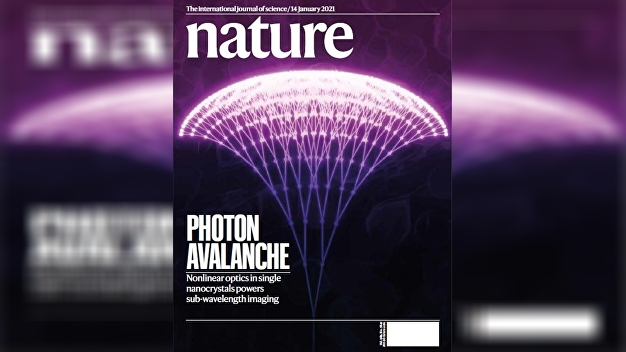
[아이뉴스24 최상국 기자] In general, when a substance absorbs light energy, some of it is consumed as thermal energy and the rest is released as less energy than the first absorbed light. However, in some elements there is also a’up-conversion’ that emits light of greater energy than the absorbed light.
It is a phenomenon in which two photons of small energy are combined to one photon of large energy, and light with a long wavelength is converted into light with a short wavelength and output. When a material absorbing near-infrared rays emits visible light, areas that could not be observed with the eye can be seen, and fragile materials can be observed without causing damage due to large energy.
However, the up-conversion nanomaterials discovered so far have a very low photoconversion efficiency of less than 1%, and have not been commercialized despite theoretical advantages. The light conversion efficiency of 1% means that only 1% of the absorbed light particles (photons) are amplified into light of greater energy.
The research team of Korea Research Institute of Chemical Technology Suh Young-deok and Nam Sang-hwan have discovered the world’s first’Photon Avalanche’, which causes a chain amplification reaction of light within the material to emit a large amount of light energy when a small amount of light energy is applied to a nanomaterial. It was announced on the 14th.
The study, which was jointly participated by researchers from Korea, the United States, and Poland, was published on the 14th as the cover paper of Nature. (Thesis Title: Giant Nonlinear Optical Responses from Photon-Avalanching Nanoparticles)
The name light avalanche nanoparticles was newly given by the research team. The research team explained that the nanoparticles that cause the optical chain amplification reaction were named because they were similar to the appearance of light causing an avalanche. Instead of being amplified one by one, the light particles are exponentially expanding like a snowball.
The nanoparticles the research team discovered for the first time in the world was synthesized by an element called’Tulium (Tm)’ in a specific atomic lattice structure (core-shell structure), and a revolutionary’up-conversion nanomaterial (UCNP) with a light conversion efficiency of 40%. UpConversion Nano Particle)’. It is 40 times higher light conversion efficiency than before.
Dr. Seo Young-deok explained, “Because it is the principle that two photons are combined into one to produce light of greater energy, the theoretically achievable maximum light conversion efficiency is 50%.”
Due to this phenomenon, it is possible to emit very strong light even by irradiating the light avalanche nanoparticles with light of a weak intensity comparable to that of a laser pointer. Through the discovery of this new phenomenon, the research team succeeded in observing at high resolution a very small 25 nm-sized material that is difficult to see with light, and published the results in a paper. (Nanoscopy imaging, which photographs materials smaller than the visible light wavelength (less than 400 nanometers) in high resolution, is a field that won the Nobel Prize in Chemistry in 2014. This research is the result of implementing ultra-high resolution nanoscopy imaging more simply.)
‘Photoslide nanoparticles’ that cause up-conversion of light with high efficiency can be widely used in biomedical fields such as virus diagnosis, advanced IoT fields such as autonomous vehicles, and renewable energy fields such as solar cells. If infrared rays of small energy are used as a light source, light does not reach foreign substances except for the sample to be measured, so there is little noise, and because it uses small energy, it does not damage the sample.
In particular, when this technology is applied to solar cells, it is expected that the efficiency can be increased by widening the wavelength range that can absorb light. Currently, Chemo-Yeon has a research team for perovskite solar cells that achieved the world’s highest efficiency. Although perovskite is cheaper than silicon, it cannot overcome silicon in terms of photoelectric efficiency due to a narrow wavelength band capable of absorbing light.
Dr. Seo Young-deok said, “Of course, we plan to conduct applied research to increase the efficiency of the battery with the Chemical Research Perovskite Solar Cell Research Team.” It plans to develop into optical sensor application technology, micro-laser technology for implantation in the body used for chemotherapy and skin beauty, etc.”
Meanwhile, the co-corresponding author of this study, Dr. Young-Duk Seo and Professor James Sheung of Columbia University in the United States recently founded the first conference in the field of up-conversion nanoparticles at the world-renowned Gordon Conference, and held the first conference in the United States in late June this year. I am going to do it.

This research received support from the Korea Research Institute of Chemical Technology’s research project, Kang So-Hyung, the Korea Research Foundation’s Global Laboratory (GRL) support project, and the Ministry of Commerce, Industry and Energy’s industrial technology innovation project.
-Co-corresponding author: Young-Duk Seo, Senior Researcher at Chemical Research Institute (GRL, Korea), Professor P. James Schuck at Columbia University (USA), etc.- Sole 1st Author: Chang-Hwan Lee, Ph.D. student at Columbia University (May 2020) ~ Aug. Visiting researcher at the Korea Research Institute of Chemical Technology)-Co-author: Sang-Hwan Nam, Senior Researcher, Chemical Research Institute
Reporter Choi Sang-guk [email protected]
